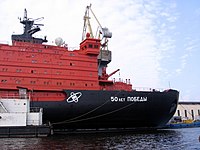Nuclear marine propulsion

Nuclear marine propulsion is a fancy way of saying that boats and ships can use the power of tiny things called atoms to move around in the water.
Imagine that atoms are like Legos. When you build something with Legos, you have to snap them together using a lot of force. When you put enough Legos together, they become something big and strong, like a castle or a spaceship.
Atoms are like Legos because they are very small and when you put them together, they can become something big and strong too. But instead of snapping together, atoms have a special kind of energy inside them called nuclear energy.
Nuclear energy is like a super powerful battery that can give a lot of power to a boat or a ship. This means that nuclear-powered boats and ships can move really fast and go very far without running out of energy.
But they cannot just use any ordinary nuclear reactor to power a boat or a ship. Special reactors are designed to be really small and easy to control. They are very safe and do not produce any harmful emissions or waste that can hurt the environment.
So, with nuclear marine propulsion, boats and ships can travel really far and really fast without hurting the planet. That's why many countries use nuclear-powered submarines to explore the oceans or defend their coastlines. But even though it is very safe, people still need to be careful when using nuclear energy because it can be dangerous if it is not handled properly.
Imagine that atoms are like Legos. When you build something with Legos, you have to snap them together using a lot of force. When you put enough Legos together, they become something big and strong, like a castle or a spaceship.
Atoms are like Legos because they are very small and when you put them together, they can become something big and strong too. But instead of snapping together, atoms have a special kind of energy inside them called nuclear energy.
Nuclear energy is like a super powerful battery that can give a lot of power to a boat or a ship. This means that nuclear-powered boats and ships can move really fast and go very far without running out of energy.
But they cannot just use any ordinary nuclear reactor to power a boat or a ship. Special reactors are designed to be really small and easy to control. They are very safe and do not produce any harmful emissions or waste that can hurt the environment.
So, with nuclear marine propulsion, boats and ships can travel really far and really fast without hurting the planet. That's why many countries use nuclear-powered submarines to explore the oceans or defend their coastlines. But even though it is very safe, people still need to be careful when using nuclear energy because it can be dangerous if it is not handled properly.
